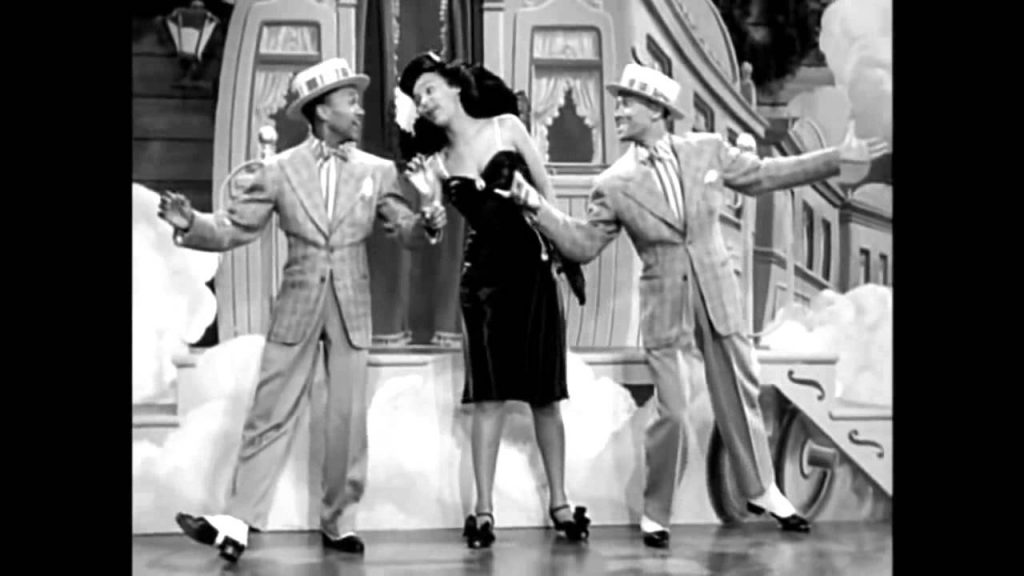It’s the evening of March 30, 1955. It’s the night of the 27th Academy Awards in Hollywood California. The celebrities are arriving in their limousines, and emerging from one of these, herded with blinding flashing lights, is a star. This star, from Cleveland, Ohio, is living out her dream. She has been nominated for the Best Actress award. Tonight, she’s making history. This woman is Dorothy Dandridge, and just for her being nominated, she is making history. Dorothy is the first African-American woman ever to be nominated for this award. And this nomination changed the way Americans thought, at least for that night. That Oscar would look so befitting in her hands. Her photo holding that Oscar from that night would be on every cover of every magazine in the country by the morning. Unfortunately, we never got to see that photo, because Dorothy did not win that night.

Dorothy Dandridge, born on November 9, 1922, first began her start in show business with her sister and another young woman in a musical trio. Once they gathered enough attention, they began performing at the Cotton Club during the 1930s.1 The famed Cotton Club was the dance club based in Harlem, New York where the most popular black singers and dancers performed, such as Cab Calloway and Duke Ellington, and it was where Dorothy Dandridge met her future husband. Here, Dorothy and her trio became so popular that they decided to take their show on tour to England. She finally married her husband, Harold Nicholas, of the Nicholas Brothers. The Nicholas Brothers were a duet who sang and tap danced together. Dorothy and Harold married on September 6, 1942. Dorothy’s marriage to Harold, however, was an unhealthy one, because her trio was receiving more fame than the Harold Brothers, causing tensions between them, and because Harold was also having affairs. But shortly after her marriage, Dorothy became pregnant and gave birth on September 2, 1943, and her baby girl was born brain damaged, due to a lack of oxygen. For the best for the child, Dorothy put her daughter in a private care agency. And after a number of years struggling with Harold and his infidelity, she finally divorced him in 1949.2
Determined to get back on her feet following the divorce, Dorothy decided to begin a solo career as a singer. It is as a singer that she gathered many fans and attention. But Dorothy always had a strong interest in acting. In 1948, when things in her marriage were rocky, she enrolled in The Actor’s Lab, which was the prestigious training school for actors in Los Angeles, California. During the 1940s, The Actor’s Lab trained many future Hollywood stars, including Marilyn Monroe. But during this period in cinematic history, it was hard for a black person to get leading roles on the big screen, especially roles that would change how black people were seen in society in general. In spite of her training at The Actor’s Lab, Dorothy would not get the opportunity to play black characters with strong, complex roles.3
As a black woman at this time in American history, if one wanted to act, one would not be given intelligent or self-respecting roles. The roles black women were given were highly stereotypical, but if acting was ones dream, as it was for Dorothy, she would take those stock roles anyway. After leaving The Actor’s Lab, Dorothy became one of those women who was offered those stock, degrading roles. Her first roles were those that had always been derogatory for black women, such as playing the role of a mistress.4 Such was the case in her films Tamango and Island in the Sun. Those roles were certainly easy for a black woman to portray. And Dorothy would receive roles like this until, finally, she landed a role alongside Harry Belafonte. Dorothy became the lead actress in the 1953 film Bright Road, in which she portrays a school teacher helping the principal, Harry Belafonte, tame their problem students. Her role in the film became a success, and it put Dorothy on the map, and brought her acclaim as an actress. But Dorothy wanted a bigger role. She sought out the lead role as Carmen in the 1954 film Carmen Jones. It was hard for black women to receive self-respecting roles in films, but ironically, in order to get such roles, one must first put on the act of not being self-respecting.5

At first, Dorothy was declined the role of Carmen Jones, and it was only after walking into the audition appearing promiscuous that she was given the role. Carmen Jones is a Broadway musical, but it was turned into a musical film starring an all-black cast, with the likes of Harry Belafonte and Pearl Bailey, and directed by Otto Preminger. Known for bringing any character she portrayed to life with her beauty, charisma, and flirtatious style, the role of Carmen Jones solidified Dorothy’s nomination. Shortly, after getting the role, she was put on the cover of Life Magazine in the same attire she auditioned in. Here Dorothy made history. Dorothy became the first African-American woman to grace the cover of Life. This role also got Dorothy Dandridge an Oscar nomination, becoming the first African-American woman nominated for the Best Actress Award. In 1955, it was hard for a black woman, or black man, to get the respect they deserved from the elite Academy of Motion Picture Arts and Sciences, much less be nominated for one of the most prestigious awards any actor can receive. This nomination was important not only for Dorothy, but for the millions of black men and boys, women and girls, who had the opportunity of watching history unfold, and being given a sense of hope and belief in themselves that they may not have had before those awards began.6
That night was important for America, for the black community, and for Dorothy, even though she did not win. She held her own going against some of the most iconic figures in film that night. The other nominees for the award were Judy Garland, Audrey Hepburn, Jane Wyman, and Grace Kelly. Grace Kelly was the winner of the award for her performance in The Country Girl.7

In Hollywood in 1955, Dorothy Dandridge was a double threat: she was a woman and she was black. Because of this, many opportunities passed her by. She was quoted as saying, “If I were Betty Grable, I could capture the world.” Betty Grable was an American singer, dancer, and actress prominent throughout the 1930s and 1940s. This much was true. Dorothy had much to offer, and it seems absurd today that such a minuscule thing such as race could keep someone from practicing their dream, but this is just what kept Dorothy and others’ dreams undermined. Unlike many, Dorothy Dandridge tackled this arbitrary system of discrimination head on, and she became a star. But she was not allowed to shine as brightly as many of her colleagues.8


After her nomination, Dorothy signed a contract with Twentieth Century Fox, entitling her to three more films. She was established as one of the biggest stars of the time. Unfortunately, Dorothy’s last role was in Preminger’s musical Porgy and Bess. On September 8, 1965 a star had truly fallen. Dorothy’s deceased body was found in her apartment. Decades later she would be reincarnated by Halle Berry in the film Introducing Dorothy Dandridge.9

Plagued by the segregation, sexism, and racism of the times, Dorothy Dandridge could not handle it and succumbed to demise. Hollywood throughout the forties and to the sixties reflected America and its racial tensions. Given the racial inequities of the era, Hollywood was not ready to have many leading roles for black women, and this showed through Dorothy’s career. Dorothy Dandridge inspired many, especially after her death. She broke many barriers for aspiring young black actors internationally. She had a dream, but because of her pigmentation, she was treated differently. Despite these odds, Dorothy was a still a formidable and respected actress. Dorothy was finally noticed as the prolific star she was, by being given an honorary star on the walk of fame on January 18, 1983, in Los Angeles, California.10
- African American Eras: Segregation to Civil Rights Times, 2011, s.v. “Dandridge, Dorothy” (1922–1965). ↵
- Rogers Patrick & Lyndon Stambler, “Overdue notice,” People 48, no. 4 (1997): 89. ↵
- Marguerite H. Rippy, “Exhuming Dorothy Dandridge: the black sex goddess and classic Hollywood cinema,” CineAction, no. 44 (1997): 21. ↵
- Louie Robinson, “The Private World of Dorothy Dandridge,” Ebony 17, no. 8 (1962): 116. ↵
- Cynthia Gorney, “The Fragile Flame of Dorothy Dandridge,” The Washington Post, February 09, 1988. ↵
- Walter Leavy, “The mystery and real-life tragedy of Dorothy Dandridge,” Ebony 49, no. 2 (December 1993): 36. ↵
- Robert K. Lightning, “Dorothy Dandridge: ruminations on black stardom,” CineAction, no. 44 (1997): 31. ↵
- Encyclopaedia Britannica, May 2017, s.v. “Dorothy Dandridge.” ↵
- Erin Anderson, “Dorothy Dandridge: Singer & Actress,” Booklist (2011), 71. ↵
- Ed Guerrero, “Dorothy Dandridge: A Biography,” Cineaste, Vol. 23 Issue 4 (1998): 60. ↵



85 comments
Maria Mancha
I really enjoyed how you told her story. Dorothy Dandridge was an amazing women and she is an inspiration to many. Your first paragraph immediately grabbed my attention especially to find out why she didnt win that award. You shared her story very well especially by emphasizing she was a true double threat by people black and an actor. Its sad that it took so long for change to happen, but the fact she never gave up was amazing. And it payed off by her getting a honorary star on the walk of fame. Therefore I learned something completely new and I really enjoyed this article.
Cristina Cabello
I really liked how you displayed this story. Especially in the beginning on how you describe a future event that did not end up happening. Dorothy seems like a very strong women who I would admire. I really like to read about the successful stories of people. The ones where they have to work hard in order to get far. I feel like most stories are based off of this. But they all still need to be recognized. The world can never have too many role models.
Carlos Vazquez
It is sad to see that African Americans did not win the award for best actress award until 2002, it just demonstrates how much progress this country has made since the days when Dorothy was on screen. Even though she didn’t win, she continued to peruse her dream and push through her struggles to be one of the best actresses.
Alyssa Childs
I loved the way the author, Aaiyanna Johnson, told the story. It saddens me to think of how long it took for people of all colors to become equal. Dorothy sounds like a very strong and independent woman who can overcome anything. I know her just being nominated was a miracle but she deserved to win and if she didn’t win just because of her color then wow our society then was messed up. Her story is one of the beautiful ones because even though she didn’t win she pushed through and still became famous for doing what she loved.
Hanadi Sonouper
Having a passion and love for film and cinema has always been a genuine interest of mine. Reading this article was very intriguing and lively, especially since because she was the first African American actress to be nominated for an academy award in the film Carmen Jones. She is an iconic figure to Hollywood, and I admire her dignity and strive to continue and pursue her dream besides her life at home and the surrounding world.
Anthony Robledo
Wow I cant believe i didnt know who Dorthy Dandridge was before this article. She is truly an iconic hero who should be remembered. The imagery you used in this article was fantastic. From the front page of TIME magazine, to being nominated to an oscar. Dorthy truly helped revolutionize the world. This article is a great way to represent what she did. Good job and keep it up.
Seth Castillo
Dorothy Dandridge really lived a hard life. She had a cheating husband, a daughter that she almost lost. Not to mention the number of atrocities African-American women had to face during that time. Through it all, she still managed to become someone famous. It’s amazing what passion can do to a person facing a hard life. Dorothy Dandridge lived a hard life to which she overcame and that alone deserves an award.
Robert Flores
I honestly have never heard of Dorothy Dandridge before this article. She was a trailblazer which are people I have always looked up to. She was also a fighter and knew no boundaries. Stories like these show that humans have no social limits. Stories like these give me hope that one day the discriminations of today will be in the past.
Thomas Fraire
Dorothy Dandridge is a truly iconic figure. Not only did she take racism head in the 40s, but she also had to overcome a cheating, jealous, and selfish husband. Finally, after the birth of her daughter, Dorothy decided to divorce her husband. She endured a cheating husband up until the birth of her daughter which no woman should have to go through. From Times to the Oscars, Dorothy really made an impact and proved her influence.
Ana Gonzalez
Great article! I really enjoyed the images and the videos that the author included in the story. They certainly depict her as a hardworking and glamorous star. We are in no way a post racial society but I am glad that people are working on making a more inclusive, and accepting country. It’s terrible that Dorothy Dandridge had to face countless of obstacles for being a woman and black! But I think that her strength was able to pave the way for countless of other black women to be motivated to follow their dreams and become stars. Dorothy must certainly be remembered!